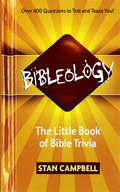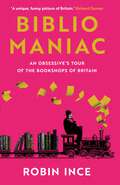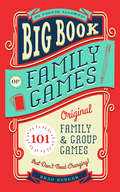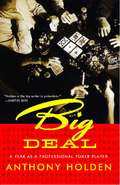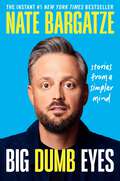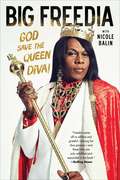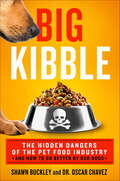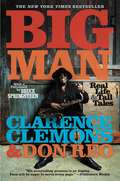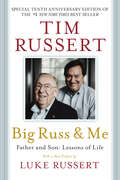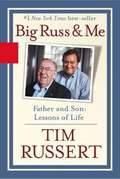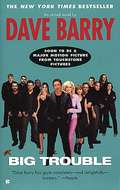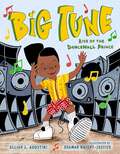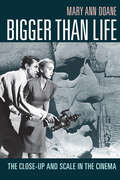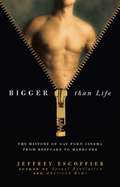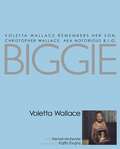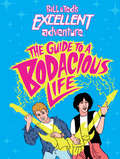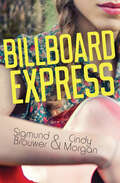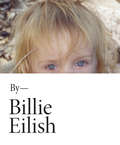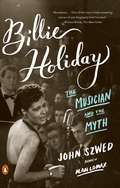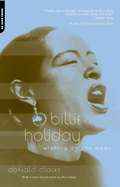- Table View
- List View
Bibleology: The Little Book of Bible Trivia
by Stan CampbellPeople who love trivia games won't be able to put down BIBLEOLOGY, which contains dozens of test-your-knowledge questions. Whether you consider yourself a novice or an expert, BIBLEOLOGY is an engaging way to get more familiar with this fascinating collection of people's interactions with the God of the universe.
Bibliomaniac: An Obsessive's Tour of the Bookshops of Britain
by Robin InceIn this warm and witty celebration of the written word, the popular comedian and presenter takes the reader on a journey across Britain as he explores his lifelong love of books and bookshops.Why play to 12,000 people when you can play to 12? In Autumn 2021, Robin Ince's stadium tour with Professor Brian Cox was postponed due to the pandemic. Rather than do nothing, he decided he would instead go on a tour of over a hundred bookshops, from Wigtown to Penzance; from Swansea to Margate.Packed with anecdotes and tall tales, Bibliomaniac follows Robin up and down the country in his quest to discover just why he can never have enough books. It is the story of an addiction and a romance, and also of an occasional points failure just outside Oxenholme.
Big Book of Family Games: 101 Original Family & Group Games that Don't Need Charging!
by Brad BergerBring family and friends together for hours of entertainment with this giant compendium of hilarious and challenging interactive games. The Big Book of Family Games brings people together for hours of fun that requires virtually nothing more than pens and paper. Perfect for family gatherings or vacations, dinner parties, or any casual group setting, this book guarantees to get people off their phones and laptops and engaging in hilarious, challenging entertainment. The 1010 thoroughly original, rigorously tested games in this book are designed to challenge each player's ability to strategize, bluff, read minds, memorize, think quickly, solve puzzles, and more. No texting, tweeting, or web surfing allowed!
Big Deal: A Year as a Professional Poker Player
by Anthony HoldenIn 1988, best-selling biographer Anthony Holden spent one year living the life of a professional poker player. His mesmerizing account of that year went on to become a classic of the genre, an inspiration to innumerable poker players and poker memoirists who followed. Big Deal is his story of days and nights in Las Vegas, Malta, and Morocco, mingling with the greats, sharpening his game, perfecting his repartee, and learning a great deal about himself in the process. Poker, Holden would insist, is a paradigm of life at its most intense, a gladiatorial contest that brings out the best as well as the worst in people. The heroes and eccentrics of the poker world stalk the pages of this remarkable book, along with all the hairraising, nail-biting excitement of the game itself.
Big Dumb Eyes: Stories from a Simpler Mind
by Nate BargatzeFrom one of the hottest stand-up comedians, Nate Bargatze brings his everyman comedy to the page in this hilarious collection of personal stories, opinions, and confessions. Nate Bargatze used to be a genius. That is, until the summer after seventh grade when he slipped, fell off a cliff, hit his head on a rock, and “my skull got, like, dented or something.” <p> Before this accident, he dreamed of being “an electric engineer, or a doctor that does brain stuff, or a math teacher who teaches the hardest math on earth.” Afterwards, all he could do was stand-up comedy. But the “brain stuff,” industry’s loss, is everyone else’s gain, because Nate went on to become one of today’s top-grossing comedians, breaking both attendance and streaming records. <p> In his highly anticipated first book, Nate talks about life as a non-genius. From stories about his first car (named Old Blue, a clunky Mazda with a tennis ball stick shift) and his travels as a Southerner (Northerners like to ask if he believes in dinosaurs), to tales of his first apartment where he was almost devoured by rats and his many debates with his wife over his chores, his diet, and even his definition of “shopping.” He also reflects on such heady topics as his irrational passion for Vandy football and the mysterious origins of sushi (how can a California roll come from old-time Japan?). <p> BIG DUMB EYES is full of heart. It will make readers laugh out loud and nod in recognition, but it probably won’t make them think too much. Nate’s family disputes this entire story. <b>New York Times Bestseller</b>
Big Eyes
by Tyler Stallings Larry Karaszewski Scott AlexanderWITH AN INTERVIEW WITH MARGARET KEANEThe full screenplay by award-winning Ed Wood writers Scott Alexander and Larry Karaszewski for acclaimed director Tim Burton's film Big Eyes, starring Amy Adams and Christoph Waltz.A rare close-up look into a corner of the 1950s and '60s art world and a perfectly observed account of a dysfunctional marriage, Big Eyes tells the true story of Margaret Keane, an artist who lived and worked in virtual slavery while her husband, Walter, gained fame and fortune passing himself off as the creator of his wife's wildly popular paintings. The story of their toxic relationship would culminate in a Hawaiian courtroom, as Margaret ultimately fights to save her name and reclaim her art, during a heated public court battle. This edition, illustrated with photos throughout, contains the complete screenplay, an afterword by the screenwriters, and an interview with Margaret Keane, the real-life subject of Big Eyes, by Tyler Stallings.
Big Freedia: God Save the Queen Diva!
by Nicole Balin Big FreediaFrom the eponymous star of one of the most popular reality shows in Fuse&’s history, this no-holds-barred memoir and &“snappily dictated story of inverted cultural norms in the wards of New Orleans&” (East Bay Express) reveals the fascinating truth about a gay, self-proclaimed mama&’s boy who exploded onto the formerly underground Bounce music scene and found acceptance, healing, self-expression, and stardom. As the &“undisputed ambassador&” of the energetic, New Orleans-based Bounce movement, Big Freedia isn&’t afraid to twerk, wiggle, and shake her way to self-confidence, and is encouraging her fans to do the same. In her engrossing memoir, Big Freedia tells the inside story of her path to fame, the peaks and valleys of her personal life, and the liberation that Bounce music brings to herself and every one of her fans who is searching for freedom. Big Freedia immediately pulls us into the relationship between her personal life and her career as an artist; being a &“twerking sissy&” is not just a job, she says, but a salvation. A place to find solace and escape from the battles she faced growing up in the worst neighborhood in New Orleans. To deal with losing loved ones to the violence on the streets, drug overdoses, and jail. To survive hurricane Katrina by living on her roof for two days with three adults and a child. To grapple with the difficulties and celebrate the joys of living. In this eye-opening memoir that bursts with energy, you&’ll learn the history of the Bounce movement and meet all the colorful characters that pepper its music scene. &“Whether detailing the highs or the lows, Freedia&’s tales pop as much as the booty that made her famous&” (Out Magazine).
Big Kibble: The Hidden Dangers of the Pet Food Industry and How to Do Better by Our Dogs
by Shawn Buckley Oscar ChavezA big, inside look at the shocking lack of regulation within the pet food industry, and how readers can dramatically improve the quality of their dogs’ lives through diet. What's really going into commercial dog food? The answer is horrifying. Big Kibble is big business: $75 billion globally. A handful of multi-national corporations dominate the industry and together own as many as 80% of all brands. This comes as a surprise to most people, but what’s even more shocking is how lax the regulations and guidelines are around these products. The guidelines—or lack thereof—for pet food allow producers to include ever-cheaper ingredients, and create ever-larger earnings. For example, “legal” ingredients in kibble include poultry feces, saw dust, expired food, and diseased meat, among other horrors. Many vets still don’t know that kibble is not the best food for dogs because Big Kibble funds the nutrition research. So far, these corporations have been able to cut corners and still market and promote feed-grade food as if it were healthful and beneficial—until now.Just as you are what you eat, so is your dog. Once you stop feeding your dog the junk that’s in kibble or cans, you have taken the first steps to improving your dog’s health, behavior and happiness.You know the unsavory side of Big Tobacco and Big Pharma. Now Shawn Buckley, Dr. Oscar Chavez, and Wendy Paris explain all you need to know about unsavory Big Kibble—and offer a brighter path forward for you and your pet.
Big Man: Real Life & Tall Tales
by Clarence Clemons Don ReoFor the first time ever comes the inside story of Clarence "Big Man" Clemons--his life before, during and beyond the E-Street Band, including unbelievable, never-before-told adventures with Bruce Springsteen, the band, and an incredible cast of other famous characters recounted by himself and his best friend, television writer/ producer Don Reo. Here are just a few things you'll get from reading it: The truth behind the final hours of making Born To Run; The real story of how the E-Street Band got its name; What happened when Clarence and Ringo Starr were sitting in a hotel room and Clarence got the call that Bruce was breaking up the band; How Bruce and Clarence met that dark, stormy night at the Student Prince; The E-Street band's show at Sing-Sing prison where all of their equipment blows out right as they take the stage; The secret that Robert De Niro told Clarence and Bruce they had to keep for 25 years. But that's merely a glimpse. This is not your average rock book. It is something creative, something unique, something new. It is the story of E-Street. It is the story of stories. It is the story of the Big Man.
Big Russ and Me: Father & Son: Lessons of Life
by Tim Russert Luke RussertOver the last two decades, before his death in 2008 at the age of 58, Tim Russert had become one of the most trusted and admired figures in American television journalism. Throughout his career he spent time with presidents and popes, world leaders and newsmakers, celebrities and sports heroes, but one person stood out to him in terms of his strength of character, modest grace and simple decency--Russert’s dad, Big Russ. In this warm, engaging memoir, a #1 New York Times bestseller upon its initial release in 2004, Russert casts a fond look back to the 1950s Buffalo neighborhood of his youth. In the close-knit Irish-Catholic community where grew up, doors were left unlocked at night; backyard ponds became makeshift ice hockey rinks in winter; and streets were commandeered as touch football fields in the fall. And he recalls the extraordinary example of his father, a WWII veteran who worked two jobs without complaint for thirty years and taught his children to appreciate the values of self-discipline, of respect, of loyalty to friends. These deep roots stayed with Russert as he forged a remarkable career, first in government and then in media, and finally in his 16 years at Meet the Press as one of the most recognized and trusted face in television news. As Russert explains, his fundamental values sprung from that small house on Woodside Avenue and the special bond he shared with his father--values he passed down to his own son, Luke. As Tim Russert celebrates the indelible connection between fathers and sons, readers everywhere will laugh and cry in identification with the life lessons of Big Russ and in mourning of Tim Russert, a big American voice in his own right. For this special 10th anniversary trade paperback edition of Big Russ & Me, Tim’s son Luke will contribute an extensive introduction, commenting on his father’s legacy, and on how these lessons passed down from his grandfather impact the third generation. Luke had just graduated from college in 2008 when his father passed away. Since then, he has followed in his father’s footsteps, working as a special correspondent and congressional reporter for NBC news and contributing frequently to various NBC and MSNBC outlets. Despite his youth, Luke has already shown that the ideals promoted by Big Russ in midcentury Buffalo still apply in 21st century New York, and that these lessons are as relevant for us as ever.
Big Russ and Me: Lessons of Life
by Tim RussertRussert looks back fondly to his 1950s Buffalo neighborhood of his youth and recalls the extraordinary example of his father, a WWII veteran who worked 2 jobs for 30 years without complaint, and taught his children to appreciate the values of self-discipline, of respect, and of loyalty to friends and family. Russert gives us reason to laugh, cry, and identify with the lessons of life taught by the indomitable Big Russ.
Big Time (Orca Limelights)
by Tom RyanGerri waits outside all night to audition for Big Time, her favorite TV singing competition. She believes she has a shot at success, but when she’s insulted by one of the judges and kicked out of the competition, she thinks she’ll probably never sing again. After a teacher at her school asks her to join a choral club, Gerri reluctantly gets involved. Even though she can’t read music and she doesn’t know the other kids, she finds herself enjoying the group and learning a lot about music. A cute guy she met at the Big Time auditions joins the group, and when they perform their unique mashups at an open-mic night, Gerri realizes there’s more than one way to be a successful—and happy—singer! This short novel is a high-interest, low-reading level book for middle-grade readers who are building reading skills, want a quick read or say they don’t like to read!
Big Trouble
by Dave BarryA teen sneaks up to shoot a cute girl with a Squirtgun to win a high school game called Killer. Meanwhile, two hit men sneak up to kill the girl's abusive stepdad, Arthur. Arthur cheated his bosses at corrupt Penultimate, Inc., which equipped a Florida jail with automatic garage-opener gates that accidentally freed prisoners in a lightning storm. Confusion happens, witnessed by a bum named Puggy, camped in a tree in Arthur's yard.
Big Tune: Rise of the Dancehall Prince
by Alliah L. AgostiniAn exuberant picture book written by Alliah L. Agostini and illustrated by Shamar Knight-Justice is about a Black boy with big dancing dreams who learns the meaning of courage and community.It’s the weekend, first in June; speaker’s blasting out big tune!Cousins, aunties, uncles, friends pack the house, and fun begins.Shane is shy but loves to dance—and all year long, he’s picked up cansto earn some money toward his goal: high-tops with a pump-up sole.But then the speaker blows—it’s done! Will this stop his family’s fun?Can Shane come through to save the day and bring back Big Tune Saturday?Set within a vibrant Caribbean American neighborhood and told to a rhythmic beat, Big Tune is a story of Black boy joy that touches on determination, confidence to express who you are, selflessness, and community gratitude.
Bigger Than Life: The Close-Up and Scale in the Cinema
by Mary Ann DoaneIn Bigger Than Life Mary Ann Doane examines how the scalar operations of cinema, especially those of the close-up, disturb and reconfigure the spectator's sense of place, space, and orientation. Doane traces the history of scalar transformations from early cinema to the contemporary use of digital technology. In the early years of cinema, audiences regarded the monumental close-up, particularly of the face, as grotesque and often horrifying, even as it sought to expose a character's interiority through its magnification of detail and expression. Today, large-scale technologies such as IMAX and surround sound strive to dissolve the cinematic frame and invade the spectator's space, “immersing” them in image and sound. The notion of immersion, Doane contends, is symptomatic of a crisis of location in technologically mediated space and a reconceptualization of position, scale, and distance. In this way, cinematic scale and its modes of spatialization and despatialization have shaped the modern subject, interpolating them into the incessant expansion of commodification.
Bigger Than Life: The History of Gay Porn Cinema from Beefcake to Hardcore
by Jeffrey EscoffierHardcore porn?both the straight and gay varieties?entered mainstream American culture in the 1970s as the sexual revolution swept away many of the cultural inhibitions and legal restraints on explicit sexual expression. The first porn movie ever to be reviewed by "Variety," the entertainment industryOCOs leading trade journal, was Wakefield PooleOCOs "Boys in the Sand" (1971), a sexually-explicit gay movie shot on Fire Island with a budget of $4000. Moviegoers, celebrities and critics?both gay and straight?flocked to see "Boys in the Sand" when it opened in mainstream movie theaters in New York, Los Angeles and San Francisco. Within a year, "Deep Throat," a heterosexual hardcore feature opened to rave reviews and a huge box office?exceeding that of many mainstream Hollywood features. Almost all of those involved in making ?commercialOCO gay pornographic movies began as amateurs in a field that had virtually never existed before, either as art or commerce. Many of their ?undergroundOCO predecessors had repeatedly suffered arrest and other forms of legal harassment. There was no developed gay market and any films made commercially were shown in adult x-rated theaters. After the Stonewall riots and the emergence of the gay liberation movement in 1969, a number of entrepreneurs began to make gay adult movies for the new mail order market. The gay porn film industry grew dramatically during the next thirty years and transformed the way men?gay men in particular?conceived of masculinity and their sexuality. "Bigger Than Life" tells that story. "
Biggie: Voletta Wallace Remembers Her Son, Christopher Wallace, aka Notorious B.I.G.
by Voletta WallaceVoletta Wallace, the mother of Christopher, aka Notorious B.I.G., became a matriarch of hip-hop on March 9, 1997, the night her legendary son was murdered. An intensely private and religious person, she was thrust into the spotlight of the media and charged with managing the legacy of a hip-hop generation immortal. Biggie reveals the story of how Ms. Wallace came to America and raised a son who -- in a life cut too short -- grew to be one of the most beloved recording artists of his generation. Ms. Wallace, born and raised in Jamaica, West Indies, immigrated to the United States as a young woman, aspiring to her version of the American Dream. Once here, she fell in love. The relationship didn't work out, but it did result in a beautiful son. The bright and precocious Christopher became the center of her world, and she the foundation of his. Ms. Wallace settled in Brooklyn, New York, pursued a career in early childhood education, and worked hard at not only keeping her own son on the straight and narrow but lovingly and firmly guiding other people's sons and daughters. Biggie is Voletta Wallace's story and her tribute-in-writing to her beloved son. In a no-holds-barred way, she tells the truth about the night her son was senselessly shot, the terrible aftermath, and what she believes led to his untimely death. She shares her misgivings about the treacherous nature of the entertainment industry and condemns the individuals who posed as friends of her late son while treating her and his memory with little respect. She acknowledges those -- the mothers of other slain hip-hop artists, including Tupac Shakur and Jason Mizell -- who gave her moral and material support in the dark moments of mourning her son and attending to the business and legal issues, many of which remain unresolved. Faith Evans, Christopher's widow, the mother of his child -- and a recording star in her own right -- contributed a heartfelt foreword to this book. Evans remains at Voletta Wallace's side as she continues the struggle to keep open the investigation of her son's murder and see that justice is done. She and so many others, in and out of the hip-hop community, continue to work with Ms. Wallace in support of the Christopher Wallace Foundation, an organization dedicated to the well-being and education of inner-city youth. For more information, visit www.cwmf.org.
Bildung nach reaktionären Revolutionen: Was sich von der TV Serie The Handmaid’s Tale lernen lässt
by Anja BesandDer vorliegende Band ist der neunte Band einer Reihe, in der sich eine Gruppe von Wissenschaftlerinnen und Wissenschaftlern, die sich 2014 an der Technischen Universität Dresden unter der Bezeichnung WEITERSEHEN – interdisziplinäre Perspektiven Dresdner Serienforschung zusammengefunden haben, mit sozial- und kulturwissenschaftlichen Fragen im Kontext aktueller TV Serien beschäftigt. Der hier vorliegende Band ist einer der Düstersten, den die Gruppe bislang vorgelegt hat. Es geht um Bildung nach reaktionären Revolutionen oder die Frage, wie wir dem autoritären Sog begegnen, der in den westlichen Gesellschaften zunehmend sichtbar wird. Im Mittelpunkt dieses Bandes steht eine dystopische Erzählung. Eine Erzählung über reaktionäre Revolutionen, Umweltkatastrophen und Reproduktionskrisen. Eine Erzählung über Unfreiheit, sexualisierte Gewalt, Maskulismus und Macht. Die Erzählung ist dabei mehr als 30 Jahre alt und gleichzeitig so aktuell, dass man sich die Augen reiben möchte. Es geht um: The Handmaids Tale – eine Serie, deren Kostüme heute regelmäßig in Demonstrationskontexten auftauchen. Eine Serie, deren Urtext bereits zum kanonischen Bestandteil schulischer Pflichtlektüren geworden ist und die doch gleichzeitig als eine der aktuellsten Serienerzählungen zu bewerten ist.
Bill & Ted's Excellent Adventure(TM): The Guide to a Bodacious Life
by Steve BehlingParty on, dudes! This excellent book of wit and wisdom celebrates the genius of the world-famous Wyld Stallyns and their time-traveling adventure.Once, Bill and Ted made history. Now, they're ready to share the knowledge they've gained traveling through time. This hardcover companion to Bill & Ted's Excellent Adventure and Bill & Ted's Bogus Journey features full-color film images and original illustrations and gives advice on how to live a non-heinous life, how to start a band when you can't play any instruments, how to find the most-triumphant locations in any food court, and how to make friends with difficult dudes -- from Genghis Khan to your history teacher! This collectible book is sure to become a most outstanding favorite, just like the excellent movies that inspired it.Bill and Ted's Excellent Adventure characters and images (TM) & © 1989, 2020 Creative Licensing Corporation. All Rights Reserved.Bill and Ted's Bogus Journey characters and images (TM) & © 1991, 2020 Creative Licensing Corporation. All Rights Reserved.
Billboard Express (Orca Limelights)
by Sigmund Brouwer Cindy MorganElle has come to Nashville to become a star. She has what it takes, but her agent and all the label executives want to change everything about her—her hair, her body, her clothes and, most important, her music. So Elle becomes a blond, sings about cookin' for her man and wears tiny shorts and revealing tank tops. Then a chance meeting with an established female songwriter makes Elle realize that she's paying too high a price for success. Billboard Express continues the story that began in Rock the Boat by Sigmund Brouwer. This short novel is a high-interest, low-reading level book for middle-grade readers who are building reading skills, want a quick read or say they don’t like to read! The epub edition of this title is fully accessible.
Billie Eilish: For Beginning Piano Solo
by Billie EilishLegendary recording artist Billie Eilish shares an intimate inside look at her life—both on and off the stage—in this stunning, photo-filled book. <P><P>Billie Eilish is a phenomenon. With distinctive visual flare and darkly poignant lyrics that are unparalleled among music icons of the 21st century, Billie is a musician who stands out from the crowd. Between her record-shattering award-winning music and her uncompromising and unapologetic attitude, it's no surprise that her fanbase continues to grow by millions month after month. She is that rare combination of wildly popular and highly respected for her prodigious talent, a once in a generation superstar. <P><P>Now in this stunning visual narrative journey through her life, she is ready to share more with her devoted audience for the first time, including hundreds of never-before-seen photos. This gorgeous book will capture the essence of Billie inside and out, offering readers personal glimpses into her childhood, her life on tour, and more. A must-have for any fan. <P><P><b>A New York Times Bestseller</b>
Billie Holiday
by John SzwedPublished in celebration of Holiday's centenary, the first biography to focus on the singer's extraordinary musical talentWhen Billie Holiday stepped into Columbia's studios in November 1933, it marked the beginning of what is arguably the most remarkable and influential career in ?twentieth-century popular music. Her voice weathered countless shifts in public taste, and new reincarnations of her continue to arrive, most recently in the form of singers like Amy Winehouse and Adele.Most of the writing on Holiday has focused on the tragic details of her life--her prostitution at the age of fourteen, her heroin addiction and alcoholism, her series of abusive relationships--or tried to correct the many fabrications of her autobiography. But now, Billie Holiday stays close to the music, to her performance style, and to the self she created and put into print, on record and on stage.Drawing on a vast amount of new material that has surfaced in the last decade, critically acclaimed jazz writer John Szwed considers how her life inflected her art, her influences, her uncanny voice and rhythmic genius, a number of her signature songs, and her legacy.
Billie Holiday: The Musician and the Myth
by John Szwed* Kirkus Best Books of 2015 selection for Biography *Published in celebration of Holiday's centenary, the first biography to focus on the singer's extraordinary musical talentWhen Billie Holiday stepped into Columbia's studios in November 1933, it marked the beginning of what is arguably the most remarkable and influential career in twentieth-century popular music. Her voice weathered countless shifts in public taste, and new reincarnations of her continue to arrive, most recently in the form of singers like Amy Winehouse and Adele.Most of the writing on Holiday has focused on the tragic details of her life--her prostitution at the age of fourteen, her heroin addiction and alcoholism, her series of abusive relationships--or tried to correct the many fabrications of her autobiography. But now, Billie Holiday stays close to the music, to her performance style, and to the self she created and put into print, on record and on stage.Drawing on a vast amount of new material that has surfaced in the last decade, critically acclaimed jazz writer John Szwed considers how her life inflected her art, her influences, her uncanny voice and rhythmic genius, a number of her signature songs, and her legacy.From the Hardcover edition.
Billie Holiday: The Musician and the Myth
by John Szwed* Kirkus Best Books of 2015 selection for Biography *Published in celebration of Holiday's centenary, the first biography to focus on the singer's extraordinary musical talentWhen Billie Holiday stepped into Columbia's studios in November 1933, it marked the beginning of what is arguably the most remarkable and influential career in twentieth-century popular music. Her voice weathered countless shifts in public taste, and new reincarnations of her continue to arrive, most recently in the form of singers like Amy Winehouse and Adele.Most of the writing on Holiday has focused on the tragic details of her life--her prostitution at the age of fourteen, her heroin addiction and alcoholism, her series of abusive relationships--or tried to correct the many fabrications of her autobiography. But now, Billie Holiday stays close to the music, to her performance style, and to the self she created and put into print, on record and on stage.Drawing on a vast amount of new material that has surfaced in the last decade, critically acclaimed jazz writer John Szwed considers how her life inflected her art, her influences, her uncanny voice and rhythmic genius, a number of her signature songs, and her legacy.From the Hardcover edition.
Billie Holiday: Wishing on the Moon
by Donald ClarkeCertainly no singer has been more mythologized and more misunderstood than Billie Holiday, who helped to create much of the mystique herself with her autobiography, Lady Sings the Blues. "Now, finally, we have a definitive biography," said Booklist of Donald Clarke's Billie Holiday, "by a deeply compassionate, respectful, and open-minded biographer [whose] portrait embraces every facet of Holiday's paradoxical nature, from her fierceness to her vulnerability, her childlikeness to her innate elegance and amazing strength. " Clarke was given unrivaled access to a treasure trove of interviews from the 1970s-interviews with those who knew Lady Day from her childhood in the streets and good-time houses of Baltimore through the early days of success in New York and into the years of fame, right up to her tragic decline and death at the age of forty-four. Clarke uses these interviews to separate fact from fiction and, in the words of the Seattle Times, "finally sets us straight. . . evoking her world in all its anguish, triumph, force and irony. " Newsday called this "a thoroughly riveting account of Holiday and her milieu. " The New York Times raved that it "may be the most thoroughly valuable of the many books on Holiday," and Helen Oakley Dance in JazzTimes said, "We should probably have to wait a long time for another life of Billie Holiday to supersede Donald Clarke's achievement. "
